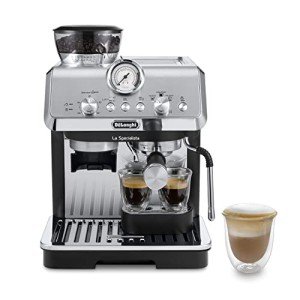The World of High-Quality Espresso Machines: A Comprehensive Guide
Espresso has ended up being a cherished drink among coffee enthusiasts worldwide, known for its rich taste, extreme scent, and flexibility. The heart of a great espresso depends on the machine used to brew it. Matte Espresso Machines -quality espresso machines are designed to provide the perfect shot, making them a necessary financial investment for coffee fans. This short article checks out numerous kinds of high-quality espresso machines, their features, maintenance ideas, and answers to regularly asked concerns.
Types of High-Quality Espresso Machines
High-quality espresso machines fall into numerous classifications, accommodating different choices, skill levels, and budgets. The primary types consist of:
| Type of Machine | Description | Ideal User |
|---|---|---|
| Manual Espresso Machines | Requires user ability to manage extraction and pressure. Uses the most control over the developing procedure. | Experienced baristas and enthusiasts |
| Semi-Automatic Machines | Combines manual operation with automation. Users control the grind and tamping, while the machine manages water dispersion. | Intermediate users |
| Automatic Espresso Machines | Automate the brewing procedure, enabling programmable developing times and temperatures. | Casual coffee drinkers |
| Super-Automatic Machines | Have built-in mills and are totally automated, managing whatever from grinding to developing and steaming. | Users seeking convenience |
| Commercial Espresso Machines | Designed for high volume use in coffee shops and restaurants, using sturdiness and speed. | Company owner |
In-depth Overview of Each Type
Manual Espresso Machines
- Pros: Complete control over the brewing process; can produce remarkable quality espresso.
- Cons: Requires significant skill; time-consuming.
Semi-Automatic Machines
- Pros: Balanced control, blending manual and automatic procedures; remarkable quality espresso is still possible.
- Cons: Requires some understanding and experience to master.
Automatic Espresso Machines
- Pros: User-friendly; reduces the finding out curve while still producing high-quality espresso.
- Cons: Still requires some understanding of coffee-making fundamentals.
Super-Automatic Machines
- Pros: Maximal convenience; little ability needed; suitable for individuals or households who want coffee without fuss.
- Cons: Higher rate point; may do not have the fine-tuning capabilities of manual machines.
Commercial Espresso Machines
- Pros: Built for longevity and performance; frequently consists of features for high-volume turns.
- Cons: Expensive; might be overkill for home use.
Key Features to Consider
When searching for a high-quality espresso machine, several key features ought to be taken into account:
- Pressure and Pump Type: Look for machines with at least 9 bars of pressure, which is necessary for drawing out the best flavor from coffee beans.
- Boiler Type: Single, double, and heat exchanger boilers each impact how the machine carries out and the speed of brewing.
- Build Quality: High-quality products such as stainless steel are preferable for durability and visual appeals.
- Ease of Use and Cleaning: Some machines require substantial cleansing, while others are developed for simple upkeep.
- Temperature Control: Consistent temperature is critical; think about machines with PID controllers for accurate control.
Benefits of High-Quality Espresso Machines
Investing in a high-quality espresso machine provides a wide variety of benefits:
- Superior Quality: High-end machines enable for greater control, causing more delicious espresso.
- Resilience: Built to last, quality machines require fewer repairs and replacements.
- Modification: Users can enjoy a tailored experience by changing grind size, shot timing, and other settings.
- Increased Convenience: Automatic and super-automatic alternatives enable aficionados to take pleasure in espresso with minimal effort.
Maintenance and Care for High-Quality Espresso Machines
To keep an espresso machine working efficiently, routine upkeep is vital. Here are tips for maintaining a high-quality espresso machine:
Descale Regularly:
- Use a descaling solution every couple of months to avoid accumulation of minerals from water, which can impact flavor and performance.
Tidy the Brew Group:
- For machines with a detachable brew group, tidy it regularly to ensure a tidy extraction.
Change Water Filters:
- Use a water filter and change it as needed to lessen impurities in your brewing water.
Daily Cleanings:
- Rinse the portafilter and group head after each use to avoid oil accumulation.
Keep an Eye on the Parts:
- Monitor seals, gaskets, and other parts for wear and tear and change them as essential.
Often Asked Questions (FAQs)
1. What is Compact Espresso Machines for beginners?
For novices, a semi-automatic machine frequently offers a good balance of use and control, enabling users to discover the skills essential for making fantastic espresso.
2. Are super-automatic machines worth the financial investment?
Yes, for those who prioritize convenience and ease over control, super-automatic machines can be a worthwhile financial investment, specifically for families or hectic experts.
3. How much should I anticipate to invest in a high-quality espresso machine?
High-quality espresso machines vary considerably in rate, with manual machines beginning at a few hundred dollars, while super-automatic or commercial machines can surpass several thousand.
4. Can I make other coffee beverages with an espresso machine?
Yes, lots of espresso machines have steam wands or accessories that permit users to develop lattes, cappuccinos, and more.
5. How long do espresso machines usually last?
With proper maintenance, high-quality espresso machines can last over a years, making them a long-term investment in your coffee enjoyment.
High-quality espresso machines yield a transformative coffee experience, whether enjoyed in the house or in a commercial setting. By comprehending the types offered, their features, and the maintenance required to keep them running efficiently, customers can make informed choices that raise their coffee-drinking experience.

